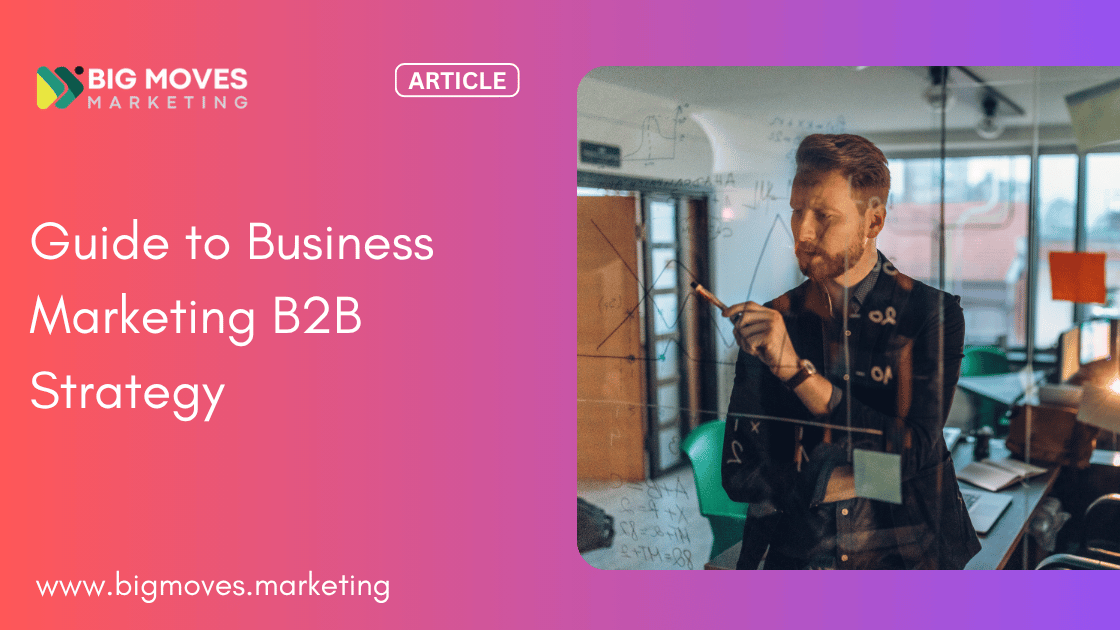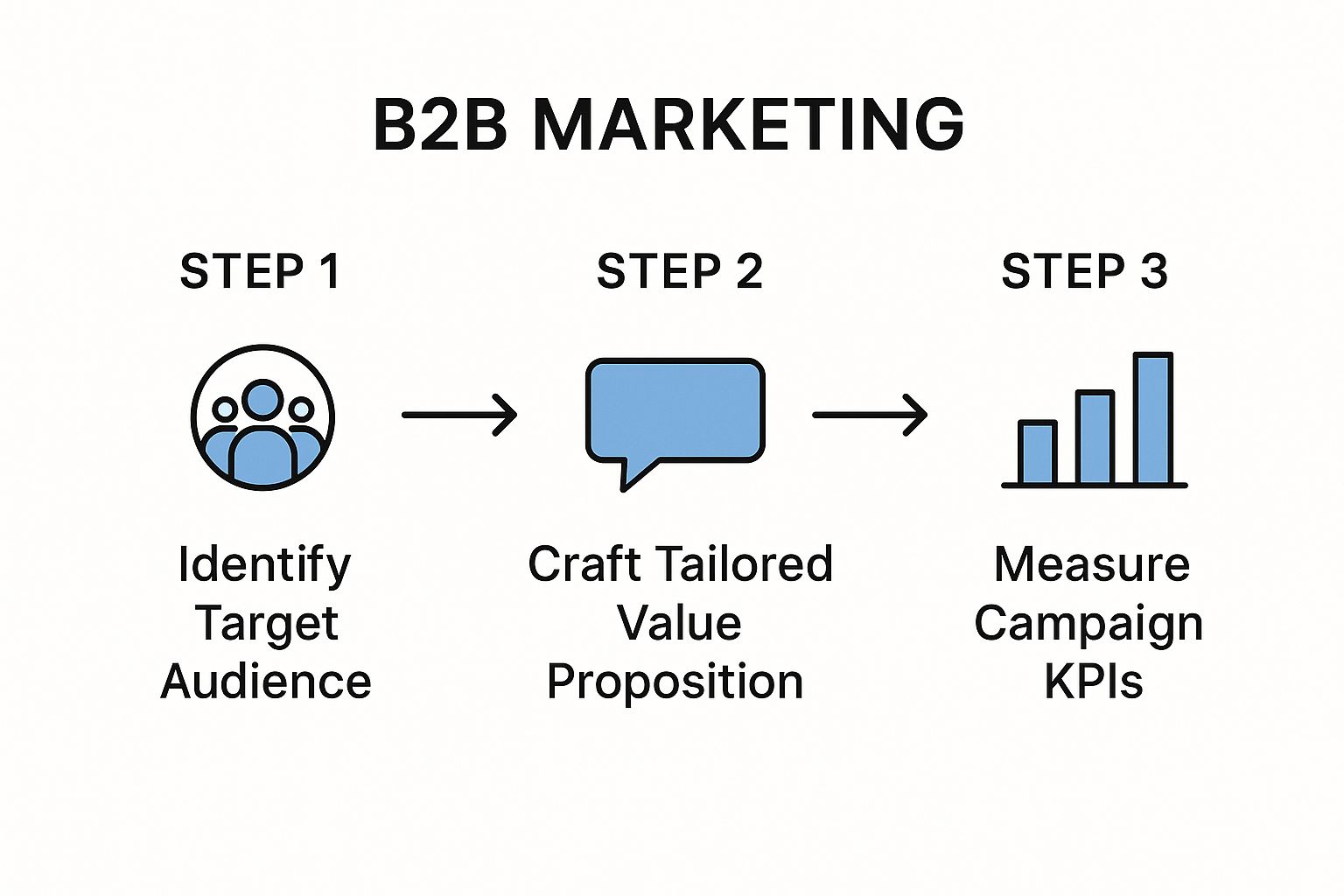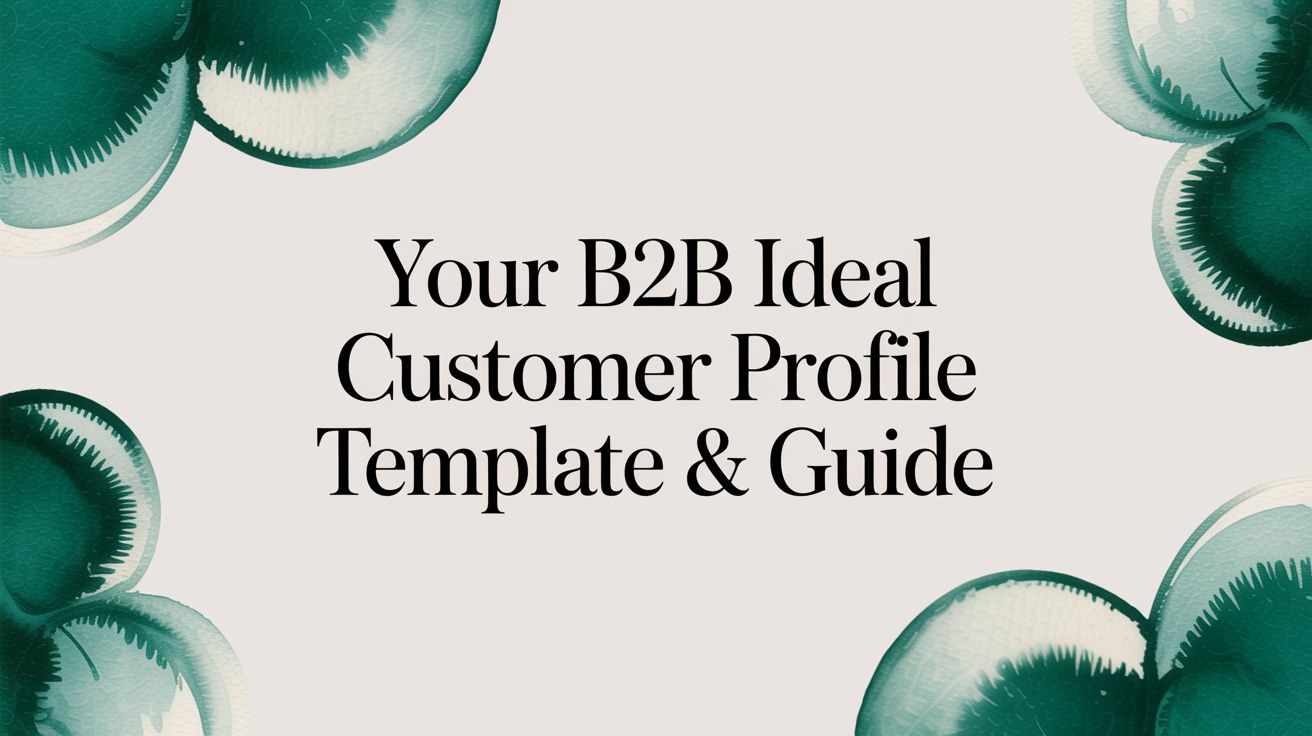Guide to Business Marketing B2B Strategy
July 16, 2025

B2B marketing isn't about quick sales; it's the art of building trust and demonstrating real value to other companies. This means focusing on long-term relationships that grow over time. To get it right, you need a deep, practical understanding of complex buying cycles, multiple decision-makers, and the specific business pains your solution actually solves.
The most effective strategies I’ve seen are always built on a solid foundation of customer empathy and hard data.
Building Your Unshakeable B2B Marketing Foundation
Let’s be honest: generic templates and one-size-fits-all advice are a waste of time. A winning B2B marketing strategy starts with a deep, almost personal understanding of your ideal customer. It’s about building an unshakeable foundation rooted in empathy so that every single action you take resonates with the right audience.
This isn’t just about creating a persona document that gathers digital dust. It's about developing an Ideal Customer Profile (ICP) that feels like a real, living guide—a composite of the organizations that get the most value from your SaaS or tech solution. Forget just looking at firmographics like company size and industry.
Defining Your Ideal Customer Profile
Your ICP is your North Star. It guides everything from product development and sales outreach to, most importantly, your marketing messages. To build a powerful ICP, start by looking at your best current customers. Who are they, really?
- Industry and Niche: What specific vertical do they operate in? Are they in FinTech, HealthTech, or Enterprise Software? Get specific.
- Company Size: How many employees do they have? What's their annual revenue? These numbers often dictate budget and buying processes.
- Technology Stack: What other software and tools do they already use? This is a goldmine for revealing integration opportunities and gauging their technical maturity.
- Pain Points: What specific business challenges drove them to you? You have to dig deeper than surface-level problems to find the root cause.
For example, "needs better project management" is a weak pain point. A precise one sounds like this: "Our engineering sprints are constantly delayed due to a lack of visibility between the product and development teams, costing us an estimated $50,000 per quarter in missed deadlines." Now that's a pain point you can build a whole campaign around.
This process isn't just a list of attributes; it's about understanding the entire context of your customer's world.

As you can see, a successful strategy moves logically from identifying the "who" (your ICP) to crafting the "what" (your message) and finally measuring the "how" (your results).
Mapping the Modern B2B Buyer Journey
Once you know who you're targeting, you need to understand how they actually buy. The B2B buyer's journey is rarely a straight line. It’s a complex, multi-touchpoint process that involves various stakeholders, from the end-user who feels the pain daily to the CFO who has to sign the check.
And things have changed. The dynamic has shifted dramatically toward self-service research and digital engagement.
Digital adoption in B2B sales has surged, fundamentally changing how buyers and sellers interact. Back in 2019, only 13% of B2B sales engagements happened online. That number is projected to hit a staggering 80% by 2025. This shift shows a massive preference for digital channels, with 83% of millennial B2B buyers favoring self-serve online orders and 66% expecting full personalization in their interactions.
Your goal is not to force a customer down a funnel. It's to be the most helpful resource at every stage of their decision-making process, building trust long before they are ready to talk to sales.
To truly build an unshakeable foundation for your marketing efforts, it's crucial to explore various effective B2B SaaS marketing strategies that have proven to drive results. This foundation of empathy, combined with a clear map of the buyer’s journey, ensures that every piece of marketing content you create—from a blog post to a case study—hits its mark and moves your business forward.
Powering Growth with a High-Impact Content Engine

Let's be clear: content is way more than just blog posts and social media updates. It's the engine that powers your entire marketing strategy. It’s how you turn your expertise into tangible assets that don’t just attract leads, but pull in high-value clients who are ready to talk business.
The most successful B2B startups I’ve seen treat their content like a product, not a marketing expense. They build a machine designed to do two things simultaneously: capture existing demand with smart SEO and create future demand with sharp thought leadership. This two-pronged attack ensures you’re grabbing the low-hanging fruit while also planting seeds for next year's harvest.
Blending SEO with Thought Leadership
First, you need a solid SEO foundation. This is your magnet for people who are actively looking for a solution right now. They're typing their pain points directly into Google, and your job is to be the best, most comprehensive answer they find. Think detailed pillar pages, tactical "how-to" guides, and blog posts that solve very specific problems related to what you sell.
But SEO alone isn't enough. Thought leadership is how you capture the attention of your future ideal customers—the ones who don't even know they need you yet. This isn't about chasing keywords; it's about earning attention by sharing a unique point of view, challenging the status quo, and offering insights they simply can't get anywhere else. It’s what makes them see their business in a new light.
The real magic happens when you fuse these two approaches. Use SEO to draw prospects in with answers to their immediate questions, then use thought leadership to build the trust and authority needed for a long-term, high-value relationship.
A great way to bridge that gap from initial interest to deeper engagement is through compelling visuals. For complex B2B products, well-crafted B2B explainer videos can be incredibly effective at showing, not just telling, your value.
This strategic blend is more critical than ever. We're seeing a major shift in how B2B buyers behave, and marketing budgets are reflecting it. In fact, 41% of US businesses plan to increase marketing spend this year, with a heavy focus on content that builds brand awareness and trust. At the same time, 40% of marketers are planning to use AI to optimize that content, showing a clear trend toward smarter, more strategic content creation.
Crafting Content That Converts
Not all content is created equal. To drive actual business outcomes, you need to map your content directly to your customer's path to purchase. A random-acts-of-content approach just doesn't work.
Here’s a practical look at how to align your content with the buyer's journey:
To help you visualize this, we’ve created a simple table that maps common content types to each stage of the B2B marketing funnel. Use this as a starting point to prioritize your content creation efforts and ensure you have the right assets to guide prospects from awareness to decision.
B2B Content Funnel Alignment

Ultimately, a well-structured content funnel doesn't just generate leads; it nurtures them. By providing the right information at the right time, you build the momentum needed to turn a curious prospect into a loyal customer.
For a much deeper dive into building a full-funnel strategy, check out our complete guide on creating a B2B content marketing strategy that drives conversions.
The Power of Undeniable Social Proof
For any tech startup, case studies are your single most powerful sales tool. They aren't just testimonials; they are evidence-based stories of transformation. A great case study doesn't just list your product's features—it quantifies the real-world impact your solution had on a client's business.
Here’s a simple but effective structure for every case study you create:
- The Challenge: Get specific about the pain. What problem was the client facing before they found you? Use their own words if you can. Vague problems get vague results.
- The Solution: Explain exactly how your product or service was implemented to solve that specific challenge. Focus on the "how" and "why," not just the "what."
- The Results: This is where you win or lose. Showcase measurable, undeniable outcomes. Did you increase their revenue by 30%? Reduce customer churn by 15%? Use hard numbers and cold, hard data to prove your value.
When you build a robust content engine fueled by strategic SEO, insightful thought leadership, and powerful social proof, you create a sustainable growth flywheel. You stop chasing every lead and start attracting the right clients who already see you as the only logical choice.
Finding and Winning on the Right B2B Channels

Let's be honest. Even the most brilliant content is useless if the right people never see it. It's time to ditch the old "spray and pray" approach to distribution. For a startup running on a tight budget, focus isn't just a strategy—it's your superpower. This is about surgically pinpointing where your buyers actually are online and then concentrating all your firepower for maximum impact.
The objective isn't to be everywhere. It's to be in the right places, showing up consistently and adding real value. This targeted approach is the beating heart of a successful business marketing B2B strategy.
LinkedIn: The B2B Goldmine
For just about any B2B SaaS or tech company, LinkedIn is non-negotiable. It’s so much more than a social network. Think of it as a dynamic, searchable database of professionals, neatly organized by industry, title, company size, and interests. The targeting capabilities are simply in a league of their own for B2B.
But winning on LinkedIn isn't about carpet-bombing inboxes with generic sales pitches. That’s a fast track to getting ignored. It’s about contribution. It’s about sharing genuine expertise, engaging in thoughtful discussions, and building a reputation as a go-to resource, not just another vendor trying to make a sale.
Here are a few ways I’ve seen work time and time again:
- Your Personal Profile is Your Digital Handshake: Make sure it screams "I help [Your ICP] solve [Their #1 Pain Point]." Your headline should be a value proposition, not just your job title.
- Share High-Value Content (Not Just Links): Post insights, ask challenging questions, or offer a peek behind the curtain of your industry. Quick, simple videos often punch way above their weight in terms of engagement.
- Engage Authentically: Block off 15 minutes every day to leave insightful comments on posts from key players in your space. Add to the conversation; don't just drop a link and run.
This isn't about chasing fleeting impressions from an ad. It's about building social capital, which pays dividends for years.
Finding Your Niche Communities
LinkedIn is the town square, but the real magic often happens in the smaller, more intimate digital-age "country clubs." Your ideal customers are gathering in niche Slack channels, private forums, and specific subreddits. These are the places where they ask for real advice, vent about their challenges, and share unfiltered opinions on new tools.
Finding these digital water coolers takes a bit of detective work. A great starting point? Just ask your best customers: "Besides LinkedIn, where do you go online to learn about your industry or talk shop with peers?" Their answers are your treasure map.
Once you’re in, the rules are simple: give, give, give before you ask. Answer questions, share your knowledge freely, and become a trusted member of the community. The moment you start overtly selling, you'll lose all the credibility you worked so hard to build.
The most powerful business marketing in B2B happens when you stop broadcasting messages and start building relationships. Your presence in these communities is about establishing trust, one helpful comment at a time.
A Startup's View on Paid Channels
Paid advertising on platforms like Google Ads and LinkedIn Ads can feel like a shortcut to results. But it can also incinerate a startup's budget with terrifying speed. The key isn't just spending money; it's surgical precision.
Forget broad campaigns. On Google, you need to focus on highly specific, high-intent keywords. Think "best CRM for small law firms," not the black hole of "CRM software." On LinkedIn, use its powerful filters to target ads to an incredibly specific audience of decision-makers.
For a startup with a limited budget, here’s how to think about it:

Spreading your budget thinly across half a dozen platforms is a classic rookie mistake. It's a recipe for burning cash with nothing to show for it. Instead, pick one or two channels that align perfectly with your ICP and go deep. Master them before you even think about expanding. For a more comprehensive look at your options, our guide on the 10 core marketing channels for B2B growth is a great resource.
By focusing your efforts, you turn your limited resources from a weakness into a strategic advantage, ensuring every single marketing dollar works as hard as you do.
Turning Leads into Revenue with Smart Nurturing

Getting a lead is a great start, but it’s just that—a start. The real work, and the real money, comes from what you do next. This is where you turn a flicker of interest into a real relationship, guiding a prospect from curious to convinced.
Think of nurturing as the critical bridge between marketing’s hard-won leads and sales’ closed deals. It’s a fundamentally human process, but it’s powered by smart automation that delivers the right message at exactly the right time. We're not talking about generic email blasts. This is about personalized, helpful engagement at scale.
Automation That Feels Personal
The point of automation isn't to replace the human element; it's to make every interaction feel more timely and relevant. Your system should come across less like a robot and more like a helpful guide who anticipates what a lead needs based on their actions.
Let’s say a prospect downloads your white paper on "AI in Logistics." A generic "Thanks for downloading" email is a missed opportunity. A smart nurturing sequence, on the other hand, looks something like this:
- Day 1: An email lands in their inbox, not from "The Marketing Team," but from a founder or product lead. It shares a key insight from the paper and asks a genuinely interesting question to spark a thought.
- Day 4: If they clicked a link in that first email, the system sends a follow-up with a case study showing how a company just like theirs used your AI solution to cut shipping costs by 15%.
- Day 10: An invitation arrives for a short, practical webinar on "Implementing Your First AI Logistics Pilot." No fluff, just value.
This sequence is responsive and respectful. It builds trust by offering help, not just pushing for a demo. To really dial this in, explore proven B2B lead nurturing strategies that can take your efforts from basic follow-ups to a revenue-generating machine.
Scoring Leads for Sales Efficiency
Let's be honest: not all leads are created equal. Your sales team’s time is their most valuable asset, and lead scoring is how you protect it. It’s a simple system of assigning points to leads based on who they are and what they do.
This data-driven method helps you instantly separate the window shoppers from the serious buyers.
- Explicit Data: This is the information they give you, like their job title or company size. A "VP of Operations" at a 500-person logistics company is obviously worth more points than an "Intern" from a different industry.
- Implicit Data: This is all about their behavior. Did they visit your pricing page? That's +10 points. Did they watch a full product demo video? That's a strong signal—give them +25 points.
Once a lead hits a pre-defined score—let's say 100 points—they are automatically flagged as a Marketing Qualified Lead (MQL) and routed straight to the sales team. This simple process ensures your reps are only spending their energy on conversations with a real shot at closing.
High-Touch Nurturing with Account-Based Marketing
For your highest-potential accounts—the ones that could truly change your startup's trajectory—a standard automated sequence just won't cut it. These prospects deserve a "white glove" approach. This is where Account-Based Marketing (ABM) shines.
Instead of casting a wide net, ABM focuses all your marketing and sales firepower on a handpicked list of target accounts. You're essentially treating an entire company as a single market.
With ABM, you stop nurturing a lead and start building a strategic relationship with a key account. The goal is to make them feel like you're their dedicated partner from the very first touchpoint.
This isn't about sending more emails. It’s about creating bespoke experiences, such as:
- Building a custom landing page just for their company.
- Sending a thoughtful, personalized gift to key decision-makers.
- Running hyper-targeted ad campaigns that speak directly to their company's biggest challenges.
This high-touch strategy creates a seamless journey from the first ad they see to the final contract they sign. To see how this fits into the bigger picture of your revenue engine, check out our guide on structuring an effective B2B sales process. By combining broad, automated nurturing for most leads with a focused ABM strategy for your top targets, you build a powerful system that turns interest into revenue.
How to Measure and Scale Your B2B Marketing
A great strategy isn’t static—it learns and adapts. This brings us to the final, and most critical, piece of your marketing engine: making data your most trusted advisor.
Without clear metrics, you're just navigating in the dark, hoping you’re pointed in the right direction. It's time to cut through the noise and focus on the numbers that actually move the needle.
Forget vanity metrics like social media impressions or total website visitors. While they might feel good, they don’t pay the bills. Instead, you need to anchor your entire strategy to Key Performance Indicators (KPIs) that directly reflect the health and profitability of your business. These are the numbers that tell you the unvarnished truth.
Identifying the KPIs That Truly Matter
For a SaaS or tech startup, your marketing dashboard should be simple, powerful, and focused on the entire customer lifecycle. It's not just about generating a flood of leads; it's about generating profitable customers who stick around for the long haul.
Your most important metrics should revolve around two central questions: How much does it cost us to acquire a customer, and how much is that customer actually worth to us over time?
- Customer Acquisition Cost (CAC): This is the total cost of your sales and marketing efforts divided by the number of new customers you brought in over a specific period. It’s the ultimate report card on your efficiency.
- Lifetime Value (LTV): This metric represents the total revenue you can reasonably expect from a single customer account. A high LTV is a clear sign you're attracting and keeping the right kind of clients.
- LTV-to-CAC Ratio: This is your golden ratio. It directly compares a customer's value to their acquisition cost. A healthy ratio, typically 3:1 or higher, is a powerful indicator of a sustainable and scalable business model.
Focusing on these bottom-line metrics forces you to make smarter decisions. It completely changes the conversation from, "How many leads did we get?" to "How many profitable customers did we create?"
Building a Dashboard That Tells a Story
Your data needs to tell a story, not just present a jumble of disconnected numbers. A well-designed marketing dashboard is your command center, connecting all your top-of-funnel activities directly to bottom-line results. It should give you the clarity you need to make bold, informed decisions with confidence.
Here’s a practical way to structure a dashboard that tells that story:

Building this kind of visibility is absolutely fundamental to growth. For a much more detailed guide on which numbers to watch and how to build your measurement framework, our article on B2B marketing analytics for growth offers a comprehensive look.
A great dashboard doesn't just show you what happened; it gives you the insights to predict what will happen next. It turns reactive marketing into proactive, strategic growth.
Using Insights to Scale Intelligently
With clear, reliable data, you finally have the power to act with conviction. Scaling isn't about doing more of everything; it's about doubling down on what’s proven to work and ruthlessly cutting what isn't.
This is where your strategy becomes a living, breathing thing. The insights from your dashboard should fuel a constant cycle of testing, learning, and optimizing.
Your action plan might look something like this:
- Double Down on Winners: If your data clearly shows that organic LinkedIn content is generating MQLs with the lowest CAC, it’s time to pour more resources there. Can you increase post frequency? Invest in better video content? Start a new series?
- Refine Your ICP: Are your best customers—the ones with the highest LTV—all coming from the FinTech sector? It might be time to update your Ideal Customer Profile and focus all your messaging on solving their specific problems.
- Optimize Underperforming Channels: If Google Ads has a sky-high CAC, don't just kill it. Dig deeper. Is the problem your landing pages? Is your ad copy missing the mark? Run some A/B tests to see if you can make the channel more efficient before pulling the plug.
This data-driven approach removes emotion and guesswork from the equation. It empowers you to make confident moves—whether that means scaling a winning channel, pivoting your messaging, or investing in new tools to personalize experiences and fuel sustainable, long-term growth.
Answering Your Top B2B Marketing Questions
Even the most buttoned-up strategy is going to spark a few questions. As you shift gears from planning to actually doing, some real-world challenges will inevitably pop up. This section is all about tackling the most common hurdles we see SaaS and tech startups face, giving you direct, actionable answers to keep you moving forward.
Your journey into business marketing B2B is definitely a marathon, not a sprint. The questions you’re asking are a good sign—it means you’re adapting as you go. Let’s get into the big ones.
How Do I Stand Out in a Crowded Market?
In a market flooded with competitors, being different is way more effective than just trying to be better. So many startups fall into the trap of an endless feature war with their rivals, which is just a race to the bottom. Instead, you need to own a unique point of view.
It's about carving out a distinct narrative for your brand. Don't just sell software; sell a completely new way of thinking about a problem. This means you have to take a stand, have a strong opinion, and build all your content around that core belief.
For instance, instead of just saying your project management tool is "faster," your angle could be that "traditional project management is broken, and here's the methodology that actually works."
The goal isn’t to be another voice in the choir. It’s to be the one with a message so clear and compelling it forces the audience to stop and listen. This is how you build a brand that attracts loyalists, not just customers.
What Is a Realistic Timeline for Content Marketing ROI?
This is the question every founder asks, and the honest answer is almost always "it depends." But for B2B, the one thing you can count on is that you’ll need patience. Content marketing is about building trust and authority, and that doesn't happen with a single blog post. You're planting seeds that will eventually grow into an orchard.
Here’s a rough idea of what to expect:
- Months 1-3: This is your foundation-building phase. Focus on consistent production and getting your initial library of content live. You might see some small bumps in traffic, but don't expect a flood of leads just yet.
- Months 4-9: This is where things start picking up. Your early content will begin ranking for long-tail keywords, organic traffic should be rising steadily, and you should see a consistent trickle of marketing-qualified leads (MQLs).
- Months 10-18+: Now the magic happens. Your authority in the space is growing, your content library starts to compound, and your lead flow becomes much more predictable. All that hard work from the early months starts to pay off with significant, scalable returns.
Can I Succeed with a Small Startup Budget?
Absolutely. In fact, a tight budget can be a secret weapon. It forces you to be smarter, more focused, and more creative—which often leads to better decisions. Instead of spraying your resources across a dozen different channels, you have to make disciplined bets on what will actually move the needle.
Start by mastering one or two channels where you know your Ideal Customer Profile (ICP) is most active. For a lot of B2B startups, this means going all-in on organic LinkedIn content and a targeted SEO strategy focused on high-intent keywords.
To make that small budget go even further, it’s critical to explore proven tactics for growth and understand the different ways you can generate interest. Our guide on B2B demand generation offers practical strategies you can start using right away.
The key is ruthless prioritization. Get comfortable saying "no" to anything that doesn't directly help you hit your main goals. Focus on high-impact, low-cost activities that build long-term assets for your business.
Feeling overwhelmed trying to connect all these strategic pieces? As fractional CMOs for B2B SaaS, Big Moves Marketing specializes in building and executing data-driven growth plans that deliver real results. We help founders like you achieve clarity and build the marketing engine your startup deserves. Schedule a free consultation to see how we can accelerate your growth.
%20-%20Alternate.svg)


%20-%20white.svg)